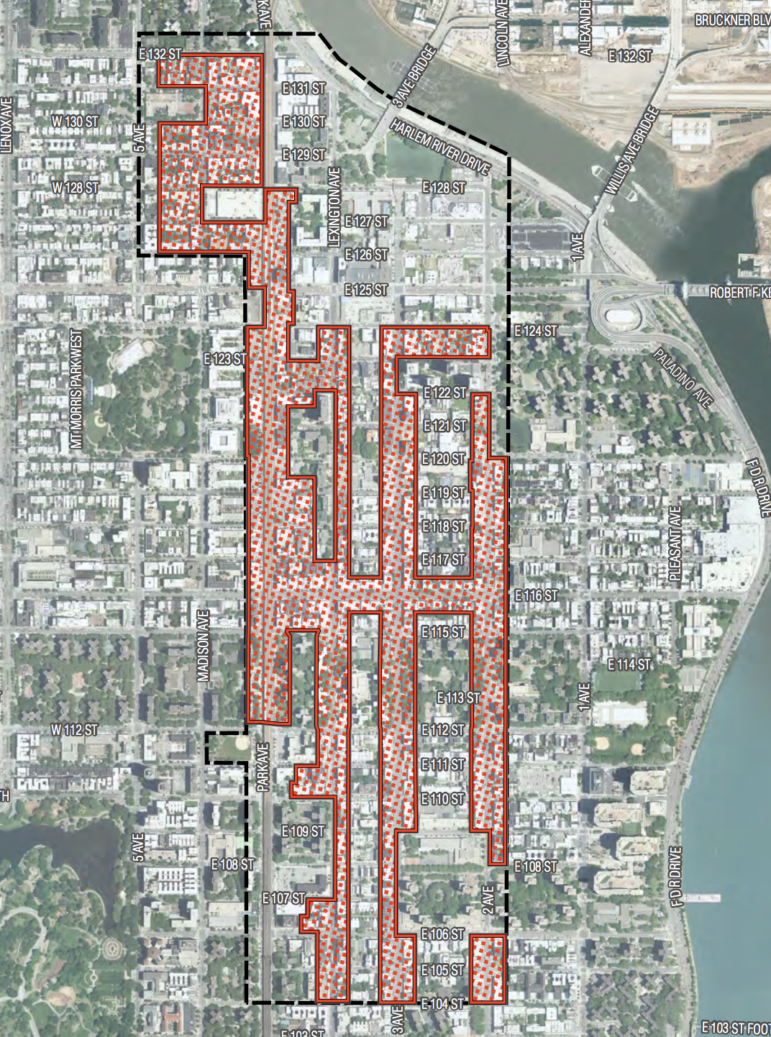
Environmental Impact Statement, Department of City Planning
An outline of the city's East Harlem rezoning.
On Thursday, the Legal Aid Society filed a lawsuit in New York County Supreme Court that seeks to halt the East Harlem rezoning, which was approved on November 30 by the City Council. The lawsuit, like the one filed by Legal Aid against the Bedford Union Armory project in Crown Heights in November, argues that the city’s environmental analysis of the rezoning fails to accurately assess the risks of “indirect displacement”— displacement caused by changing market conditions and rising rents.
Specifically, it argues that the city’s manual for conducting environmental assessments was developed without legally required public input, that the manual ignores the risks of displacement faced by rent-stabilized tenants, and that the manual “ignores the undertows of gentrification and how this compounds with rezoning to exacerbate housing pressures and accelerate tenant displacement.”
A press release sent yesterday was accompanied by quotes of support from a member of Community Voices Heard, the president of East Harlem Preservation, and representatives from the Urban Homesteading Assistance Board, Tenants and Neighbors, New York Communities for Change, and Picture the Homeless.
Legal Aid says its seeks to join the lawsuit with its litigation against the Bedford Union Armory, which will have its day in court this March.
A spokesperson for the De Blasio administration told Crain’s New York that “It’s a sad day when groups try and grab headlines by trying to halt new schools, parks, anti-eviction services and thousands of affordable apartments for some of the lowest-income New Yorkers…this plan invests in the very people who call East Harlem home today.”
Read the suit yourself:









5 thoughts on “Read Legal Aid’s Lawsuit To Stop East Harlem Rezoning”
Do not forget the $48 Billion price tag for this Mayor’s Housing Plan that will subsidize the luxury units that will ultimately exacerbate market rates to rise creating the Displacement this plan conveniently forgot to mention… This plan was a sham from day one. Who do they think they were trying to kid? This is an embarrassment for all the elected officials who supported this plan without fully assessing the detrimental impact upon low income families, even when we noted that and made it plain and simple to everyone listening. Inconsiderate elected officials are disgraceful to this community, and to the City. Basta Ya!
Not entirely sure of the strategy here because the status quo will only make things worse. This is a pretty generous initiative and the city desperately needs new housing capacity. Chiseling away at any progressive initiative is just going to make it even worse for the future of housing in NYC.
I am also not sure how you quantitatively analyze housing that is rent regulated. If development causes rent regulated units to be destroyed, it’s not City Planning’s fault. It’s an enforcement issue with HPD and the State of New York. Talk about shooting the messenger.
DeBlasio just doesn’t get it. The City cannot disrespect a community–in East Harlem blow off 2 years of work by residents–and expect ready acceptance. A lawsuit was overdue.
East Harlem residents and community groups worked for 2 years on their own plan, with the support of their Council Member, then the City blew them off with a much more developer-friendly gentrification-loaded rezoning plan. While negotiations led to some changes a bit in the direction of the community’s plan, many residents and community groups felt they were not nearly enough and they ultimately felt sold-out.
Whatever the merits of the rezoning plan that passed City Council, when residents feel disrespected, further resistance is to be expected, of which this lawsuit is a manifestation.
The City should expect more to come. The issues cited by Legal Aid in East Harlem are present (and then some) here in Inwood where a proposed rezoning is starting ULURP. We’re identifying even more issues in Inwood that could be legally challenged.
The narrative over “affordable housing” omits the social environmental impact that the law suit refers to. The plan to gentrify the “inner-city” began after WWII & the Korean Conflict when White veterans of those wars received the GI Bill benefits of loans & grants and decided to leave the urban landscape for the suburbs. The period of the 1960s through the 1990s saw a plan to warehouse property for a later time when real estate values in urban neighborhoods would rise and developers can displace those left behind & those who chose to stay as well as recent arrivals for the same preferred class of residents for whom the suburbs were created.
Pingback: News (January 2018)